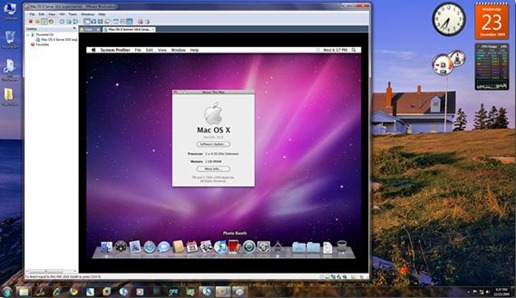


- #Vm for mac osx for mac os x#
- #Vm for mac osx install#
- #Vm for mac osx driver#
- #Vm for mac osx full#
- #Vm for mac osx code#
In this article, I’m going to show you step by step to install macOS Catalina on VirtualBox on Windows PC. To automatically boot into OS X without needing to press enter at the prompt, edit (create) the file at /Extra/.It’s been a while that macOS Catalina 10.15 is released and this is the latest Apple Mac Operating system up to now. Download and install Chimera to get started. It’s easy to install and will allow us to boot to OS X automatically and remove the -kernel argument to QEMU.

ChimeraĬhimera is a bootloader which was forked from Chameleon. The best option that I have found is to use the std video card.
#Vm for mac osx driver#
However, this driver caused a kernel panic on boot so this option too fails. There’s even a VMsvga2 driver for it on OS X. QEMU also supports the vmware video card. Which this works fine over QEMU’s VNC server (though with a low color depth), the display glitches when using OS X’s Screen Sharing feature. QEMU emulates a Cirrus Logic GD5446 video card by default. Just install the driver, shutdown, and change the NIC model from e1000 to virtio in the QEMU command.
#Vm for mac osx for mac os x#
There is a virtio-net driver for Mac OS X which works great. net nic,model =e1000,netdev =net0,macaddr =DE:AD:BE:EF:CA:FE -netdev tap,id =net0 Virtio To enable it for bridged networking, add a network bridge for KVM just add something like the following to the QEMU command: The patches to QEMU include fixes to make the e1000 device work under OS X. You can allow normal VNC viewers to connect by clicking on “Computer Settings…” in the Screen Sharing options. If you enable OS X’s internal screen sharing and use it in place of QEMU’s VNC server then mouse positioning works perfectly. OS X, unfortunately, does not support this device. Most KVM guests can make use of the tablet device to synchronize the position of the mouse with it’s position over the VNC window. Resuming from sleep doesn’t work and will cause the virtual machine to lock up. Configuring Energy Saverĭisable “Computer sleep” and “Display sleep” in the System Preferences. …though as you can see, it’s not exactly perfect. Now you should have a mostly functional Mac OS X installation! I skipped setting up an Apple ID and registering. Choose the Macintosh HD drive in Chameleon again to configure the install. The install will continue and reboot once more. Choose the (Installer) Macintosh HD partition to continue with the install. The installer will reboot and put you back on the Chameleon prompt. Install to the disk partition you just created. Hopefully the installer should just start right up.Ĭontinue with the installer and start up Disk Utility to partition your drive.Ĭlose Disk Utility and continue with the Reinstall OS X option. While the keyboard works reliably once OS X boots, it sometimes has problems on the Chameleon boot prompt.
#Vm for mac osx full#
If your terminal is filled with usb-kbd: warning: key event queue full and the keyboard doesn’t respond, just try again. If you get a kernel panic here, make sure your OS X iso image is clean, not a hacked osx86 image. You can use -v for a verbose boot which can aid in troubleshooting. Now connect over VNC and you should see the Chameleon boot prompt. drive id =MacDVD,if =none,snapshot =on,file =./mountain-lion-10.8.5.iso -boot once =d device ide-drive,bus =ide.0,drive =MacDVD \ drive id =MacHDD,if =none,cache =none,file =./mac_hdd.img \ device ide-drive,bus =ide.2,drive =MacHDD \ device isa-applesmc,osk = "INSERT OSK KEY HERE" \ Sudo bin/qemu-system-x86_64 -enable-kvm \ I’ve included a binary of it in the above download.įor Linux on Mac users, Gabriel Somlo’s site has a C program which can retrieve this key.
#Vm for mac osx code#
This key is the same in all Macs and can be easily retrieved.įor OS X users, the Mac OS X Internals website has the source code to a program which can retrieve the key. The AppleSMC device needs a valid OSK key to function. It even supports creating an SSH tunnel automatically which is very handy. VNC ClientĬhicken is a great VNC client for OS X. cdr by default, but it’s the same thing). If you have a DMG image then you can use Disk Utility’s “Convert” feature to make an ISO image (. It’s best to use the InstallESD.dmg located inside of the Install OS X Mountain Lion.app bundle. It’s important to have a clean disk image, not a hacked osx86 image because some of the kexts on the hacked images will cause a kernel panic on boot. I’m using Mac OS X Mountain Lion 10.8.5 for this. bin/qemu-img create -f qcow2 mac_hdd.img 20Gįormatting 'mac_hdd.img', fmt =qcow2 size = 21474836480 encryption =off cluster_size = 65536 lazy_refcounts =off Mac OS X Installation Disc Image


 0 kommentar(er)
0 kommentar(er)
